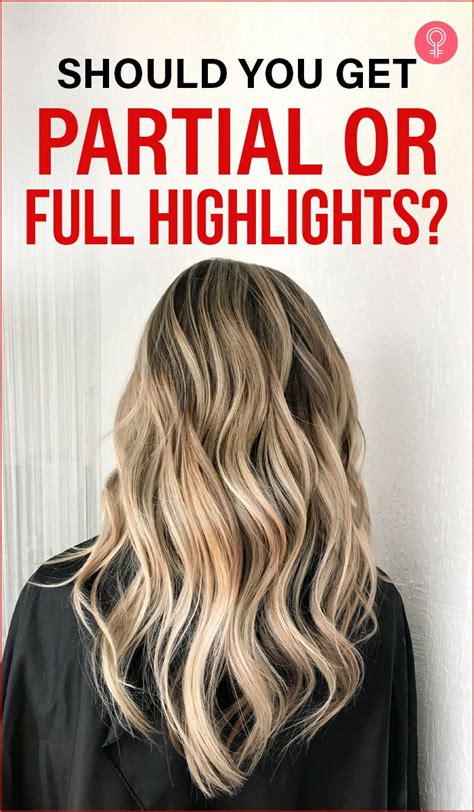Introduction
Hair highlighting is a versatile hair coloring technique that involves lightening strands of hair to create contrast. While there are numerous highlighting variations, full and partial highlights stand out as the most popular choices. Understanding the distinctions between these two methods will empower you to make an informed decision about the ideal technique for your hair and desired outcome.

Full Highlights
What is Full Highlight?
Full highlight involves lightening all of the hair’s strands from root to tip. This creates a high-impact, dimensional look that can range from subtle to bold, depending on the intensity of the bleaching process.
Benefits of Full Highlights:
- High Contrast: Full highlights provide the most contrast compared to other highlighting techniques, creating a dramatic and eye-catching look.
- Natural-Looking Results: When blended correctly, full highlights can mimic natural sunlight’s lightening effects, resulting in a sun-kissed, beachy appearance.
- Covers Gray Hair Effectively: Due to its all-over coverage, full highlight is an effective method for disguising gray hair.
Considerations for Full Highlights:
- High Maintenance: Full highlights require regular touch-ups every 4-6 weeks to maintain the desired contrast.
- Damage Potential: Bleaching the entire hair can lead to dryness and breakage if not properly cared for.
- Time-Consuming: Full highlights can be a lengthy process, typically taking several hours to complete.
Partial Highlights
What is Partial Highlight?
Partial highlight involves lightening selected strands of hair, typically around the face or crown. This technique creates a more subtle, low-maintenance look compared to full highlights.
Benefits of Partial Highlights:
- Lower Maintenance: Partial highlights require less frequent touch-ups, typically every 8-12 weeks, as the roots grow out less noticeably.
- Less Damage: As only a portion of the hair is bleached, partial highlights cause less damage to the hair shaft.
- Versatile Styling: Partial highlights offer flexibility in styling, as the unhighlighted sections can be combined with different hair colors or left natural.
Considerations for Partial Highlights:
- Limited Contrast: Partial highlights create a less dramatic contrast than full highlights, resulting in a more subtle, natural look.
- Focus on Specific Areas: Partial highlights are ideal for framing the face or adding dimension to specific areas, rather than creating an all-over lightening effect.
- Limited Coverage of Gray Hair: Partial highlights may not be as effective in covering gray hair as full highlights.
Full Highlight vs Partial Highlight: Quick Comparison
| Feature | Full Highlight | Partial Highlight |
|---|---|---|
| Lightened Strands | All Hair | Selected Strands |
| Contrast | High | Subtle |
| Natural-Looking | Mimics Sunlight | Less Noticeable |
| Gray Hair Coverage | Effective | Limited |
| Maintenance | Requires Regular Touch-Ups | Less Frequent Touch-Ups |
| Damage Potential | Moderate to High | Low to Moderate |
| Versatility | Limited Styling Options | Flexible Styling Options |
Choosing Between Full and Partial Highlights
The ideal highlighting technique for you depends on several factors:
- Desired Contrast: For a bold, dramatic look, opt for full highlights. For a more subtle, natural effect, choose partial highlights.
- Hair Condition: If your hair is dry or damaged, partial highlights may be less damaging.
- Time and Budget: Full highlights are more time-consuming and expensive than partial highlights.
- Styling Habits: For those who frequently change their hair color or style, partial highlights offer more flexibility.
Creative Applications for Hair Highlights
Beyond traditional highlighting techniques, consider these innovative applications:
- Halo Highlight: Create a subtle halo effect around the crown for a diffused, ethereal look.
- Money Piece Highlight: Frame the face with bold, contrasting highlights for a chic and modern touch.
Common Mistakes to Avoid
- Over-Bleaching: Excessive bleaching can lead to hair damage and breakage.
- Uneven Application: Ensure even distribution of lightener for a seamless, blended look.
- Ignoring Toner: Toner neutralizes unwanted yellow or orange tones to enhance the final color result.
Frequently Asked Questions
-
How often should I get highlights?
– Full highlights: 4-6 weeks
– Partial highlights: 8-12 weeks -
How much do highlights cost?
– Varies based on technique, salon, and hair length -
Can I highlight my hair at home?
– Possible, but professional results require proper training and products -
How can I prevent hair damage from highlights?
– Use sulfate-free shampoos, deep condition regularly, and avoid excessive heat styling -
Can I highlight my hair if it’s already colored?
– Yes, but consult a professional hairstylist to determine if the hair is healthy enough for further processing
Conclusion
Full and partial highlights offer distinct advantages and limitations. By understanding the characteristics and considerations of each technique, you can make an informed decision that aligns with your desired look and hair health goals. Whether you prefer a bold, eye-catching style or a more subtle, natural effect, highlights are a versatile tool for transforming your hair.
